Parmatma Banne Ki Kala
Added to library: September 2, 2025

Summary
This Jain text, "Parmatma Banne ki Kala" (The Art of Becoming God-like), authored by Sadhvi Priyranjanashreeji and published by Parshwamani Tirth, is a spiritual guide based on the "Panchsutra" (Five Sutras). The book aims to illuminate the path for individuals to achieve spiritual perfection and attain the state of a "Parmatma" (God-like being).
The text is structured around the five sutras, with this volume focusing on the first sutra, "Pap Pratighat Gun Bijadhan" (Negating Sins and Planting the Seeds of Virtues). The core message is that the journey towards spiritual perfection begins with the renunciation of sins and the cultivation of virtues.
Key Themes and Concepts:
- The Nature of the World: The book emphasizes the inherent suffering in the world, describing it as "Dukharupe, Dukhkaphale, Dukhanubandhe" – full of suffering, yielding suffering as a result, and perpetuating suffering in a continuous cycle. This suffering arises from ignorance, attachment, aversion, and karma.
- The Goal of Life: The ultimate goal is liberation (Moksha), the attainment of eternal peace and bliss, which is the true nature of the soul. This liberation is achieved by shedding karma.
- The Path to Liberation: The path to liberation involves several stages, starting with:
- Pap Pratighat (Negating Sins): This is the primary step, focusing on the cessation of sinful activities. The book delves into understanding the nature of sin, its consequences, and methods to overcome it.
- Gun Bijadhan (Planting Seeds of Virtues): After negating sins, the focus shifts to cultivating virtues like non-violence, truthfulness, non-stealing, celibacy, and non-possession (the five vows). This involves introspection, developing positive qualities, and performing virtuous deeds.
- Panchsutra: The entire framework of the book is built upon the five sutras, which provide a systematic approach to spiritual development. The first sutra, "Pap Pratighat Gun Bijadhan," lays the foundation for this journey.
- The Importance of Pure Dharma: The text stresses the significance of "Shuddha Dharma" (Pure Dharma), which is attained through the destruction of sinful karma and the cultivation of virtues.
- The Role of Penance and Right Conduct: The book highlights the importance of repentance (Garda), sincere self-reflection on past wrongdoings, and seeking forgiveness. It also emphasizes the practice of virtuous conduct (Sukrit Anu-modana) and appreciating the good deeds of others.
- The Fourfold Refuge (Char Sharan): A significant portion of the text is dedicated to explaining the importance of taking refuge in the four supreme entities:
- Arihants: The liberated souls who have conquered internal enemies like passions and karma.
- Siddhas: The souls who have achieved eternal liberation and reside in the highest realm.
- Sadhus/Munis: The spiritual guides and exemplars who practice asceticism and uphold the Jain principles.
- Dharma: The teachings and principles of Jainism, the path to liberation. Taking refuge in these four is considered essential for protection from worldly suffering and for spiritual progress.
- Svadhyaya (Self-Study): The text underscores the importance of self-reflection, introspection, and studying spiritual texts to understand one's own nature, strengths, and weaknesses.
- Purity of Intention (Pranidhan): The book emphasizes that actions, even virtuous ones, must be performed with pure intentions and unwavering devotion to be truly effective in spiritual growth. This includes having a strong resolve to practice what is preached and to follow the teachings sincerely.
- The Fivefold Path of Spiritual Development: The book outlines five key aspects for spiritual advancement: Jnana-achar (knowledge conduct), Darshan-achar (faith conduct), Charitra-achar (behavior conduct), Tapa-achar (asceticism conduct), and Virya-achar (energy conduct).
- Renunciation and Detachment: The text advocates for detachment from worldly pleasures, possessions, and relationships, viewing them as transient and ultimately sources of suffering.
- The Power of Faith and Devotion: Strong faith in the teachings of the Tirthankaras, the wisdom of the scriptures, and the guidance of the Sadhus is presented as a crucial element for spiritual progress.
Structure and Content:
The book is divided into five "Khandas" (sections), each elaborating on one of the five sutras of the Panchsutra. The provided text focuses on the detailed commentary on the first sutra, "Pap Pratighat Gun Bijadhan." This section includes:
- Mangalacharan (Invocation): The text begins with prayers and salutations to the Arihants and other enlightened beings.
- Detailed Explanation of the First Sutra: This section systematically breaks down the first sutra, explaining its philosophical underpinnings, the nature of suffering, the importance of renouncing sins, and the methods for cultivating virtues.
- Illustrative Stories and Examples: The book uses narratives from Jain scriptures and the lives of great souls (like Sulsa, Ambar, Kandak Muni, Shalikbhadra, etc.) to illustrate its teachings and make them relatable.
- The Four Sharan: The concept of taking refuge in Arihants, Siddhas, Sadhus, and Dharma is extensively discussed, highlighting their unique qualities and how their refuge protects devotees from worldly dangers and leads them towards liberation.
- Dushkrit Garda (Repentance of Wrongdoings): A significant portion is dedicated to the practice of confessing and repenting for past sins and wrongdoings, emphasizing sincerity and the desire for self-purification.
- Sukrit Anu-modana (Appreciating Good Deeds): The text encourages the appreciation and admiration of virtuous actions performed by others, including the Arihants, Siddhas, Sadhus, and even exemplary lay followers. This appreciation is seen as a way to internalize virtues.
- The Importance of Bhav (Inner State): Throughout the text, the emphasis is placed on the internal state of mind, the purity of intentions, and the sincerity of emotions (Bhav) rather than just the external performance of rituals.
Overall Message:
"Parmatma Banne ki Kala" presents a comprehensive and practical guide for spiritual seekers within the Jain tradition. It stresses the gradual but determined effort required to shed negative karmic influences, cultivate virtuous qualities, and ultimately transcend the cycle of birth and death to achieve the ultimate goal of spiritual perfection. The book encourages readers to actively engage with the teachings, reflect on their lives, and make sincere efforts to transform themselves through right faith, knowledge, and conduct.